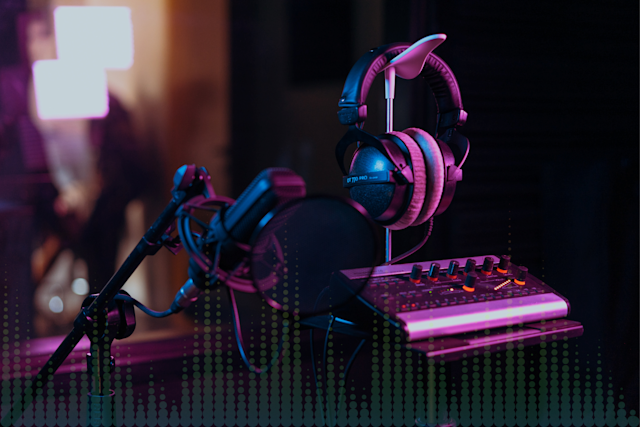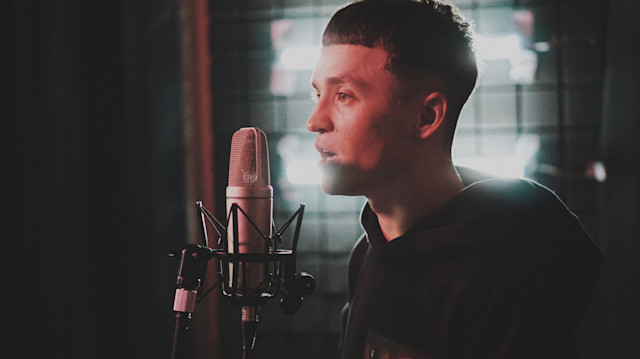The Science of Audio Recording - A Beginner's Guide
November 15, 2023 | Tero Potila

Audio recording is a foundational skill, whether you’re recording a podcast or creating and producing music. It's an essential part of the workflow and can truly make or break your final product.
With modern Digital Audio Workstations (DAWs), audio recording has never been more approachable. You can easily learn to use a wide range of available tools and techniques to record high-quality audio regardless of your level of expertise as long as you follow some basic rules.
You no longer need expensive, bulky equipment to produce professional-sounding audio. Of course, high-end recording studios still have a place in the industry, but a simple setup is sufficient for most projects when you're just getting started.
Recording Audio Online
There are many online tools and applications that can help you capture any audio elements with just a button click. One great example is Soundtrap, a cloud-based DAW that gives you the professional platform of a traditional DAW combined with the flexibility of online access and sharing. Capturing audio for your project couldn't be easier if you're using a computer or mobile device.
It's important to understand the basic science of audio recording before you get started, like microphone choices and setup, audio interfaces, and audio formats. These fundamentals will make your experience smoother and ensure you capture professional quality and tone.
AUDIO RECORDINGS - Setup, Connecting Devices and Recording
Audio Recording Basics
Learning the process of capturing and manipulating sound is essential for songwriting, composing, music production, podcasting, radio broadcasting, and film and video production.
First Step
You need an audio interface, microphones, and an audio software setup. The audio recording software helps convert digital audio signals from your audio interface into sound files you can edit, mix, and manipulate.
You can install a DAW locally on your computer or use a cloud-based solution like Soundtrap for the software.
Commonly Used Audio Formats and Settings
Audio is typically recorded in WAV or AIFF file formats into your DAW. Once your project is mixed, mastered, and ready for release, it's often delivered as a FLAC or mp3 file, depending on the release platform's requirements.
Choosing the right audio format is important in order to maximize the quality of the final product.
Bit Depth
When it comes to digital audio file settings, one crucial aspect to consider is bit depth: the higher the bit depth, the more accurate the audio signal's digital representation. High-quality recording software commonly uses bit depths of 16-bit, 24-bit, and 32-bit float. Higher bit depths allow for more headroom and clarity.
Sample Rate
Another essential parameter is the sample rate. The most common sample rates are 44.1 kHz, 48 kHz, 88.2 kHz, and 96 kHz. A higher sample rate generally results in better audio quality but may require more processing power and storage.
Industry Standard and Quality Considerations
When you choose bit depth and sample rate settings, keep in mind that the bit depth makes the biggest difference in the audio quality; always choose at least 24-bit depth if available.
The important thing about the sample rate is to choose a setting that matches your target use. Film and TV projects, for example, typically require a 48kHz sample rate, so it makes sense to record audio at that sample rate. Music for streaming platforms is typically delivered at a 44.1kHz sample rate.
The bit depth and sample rate can be converted later to whatever the final requirements. However, making as few conversions as possible is a good idea to preserve the highest possible quality.
While these simple steps may seem trivial, they can greatly enhance the quality of your final production.
Recording Environment And Noise
Always make sure your recording environment is free from any unwanted noise. Capturing the best possible quality recording of the audio source will make your final product sound more professional.
Choosing the Right Tools
The best options for recording gear choices depend on your project requirements. There are many options available that are portable, easy to use, and still capture great quality.
Audio Recorders
Even smartphones can record usable audio at the basic level, but their microphones are limited and deliver barely good enough sound.
A dedicated audio recorder is the next step up; they are designed to capture higher-quality sound and are great for capturing audio when portability is important.
Professional Microphones
Dedicated professional microphones provide the best quality recordings. The right microphone for you will depend on the type of sound you're capturing, the recording environment, and your budget:
Dynamic microphones are versatile, durable, and typically less expensive than condenser microphones. They work well in various environments, making them popular for recording situations. They can handle louder sound sources but, on the other hand, don't capture as much detail as condenser microphones.
Condenser microphones provide a more accurate and sensitive sound capture, making them ideal for capturing subtle nuances in music or vocals. However, they can be more delicate and require an external power source called phantom power, typically provided by an audio interface.
Ribbon microphones offer a unique sound profile, capturing warmth and detail. While less common, they excel in reproducing nuanced tones, making them ideal for certain music genres and specific recording environments. However, they require careful handling due to their delicate ribbon design.
Lavalier microphones are small clip-on mics often used in interviews and for recording speech. They're convenient for situations where hands-free operation is necessary and offer a discreet appearance. Lavalier microphones are available as both dynamic and condenser microphones.
Audio Interfaces
Most professional microphones require an audio interface with phantom power. The other benefit of high-quality audio interfaces is they typically come with better analog-to-digital converters, which ensure the digital representation of the source audio is cleaner and higher quality.

Dedicated professional microphones provide the best quality recordings.
Choosing Your DAW
You have a wide range of options for the Digital Audio Workstation. One of the most convenient options is Soundtrap, a remote recording platform. Soundtrap lets you record, edit, produce, mix, and master all in the cloud. Your collaborators can also work directly on the same projects with you.
Tips for Reducing Noise
Recording high-quality audio is essential for any project, but sometimes unwanted background noise can be a challenge to eliminate.
Choose an appropriate location for your recording. Opt for a quiet space with minimal echo or reverberation, as this will make a huge difference in the quality of the final product.
Ideally, you should work in an acoustically treated room like a home studio. If that's not an option, you'd want a room with soft materials, like carpets, curtains, or upholstered furniture, to absorb sound and reduce reflections off hard surfaces.
Next, choose the right mic for the job: A directional microphone focusing on your voice or sound source greatly reduces background noise from other directions.
Position the microphone at an optimal distance, usually 6-12 inches from the sound source. This helps capture the instrument or voice while minimizing any potential breathing or handling noise.
Check your surroundings and try to control any noise sources within the room. Turning off unnecessary electronic devices during your recording session can help you capture cleaner audio.
If you still deal with unwanted noise in your recordings, you can employ some noise reduction techniques, like the Soundtrap Vocal Cleanup (Powered by AI), during post-processing. Many free and paid software tools are designed to help you remove or at least reduce different types of noise.
You should always make every effort to capture the highest possible quality audio and only use noise reduction in post-production as a last resort.
Advanced Recording Techniques
Microphones
Experiment with different microphones to find the best one for the target sound source.
There are microphones with different polar patterns that are best suited for different tasks. Some microphones also have a specific 'sound' that makes them perfect, for example, when you want to capture warmer tone vocals or acoustic instruments.
Proper microphone placement is also crucial. Experiment with different positions and angles to find the sweet spot that captures the desired sound with minimal unwanted noise. Keep in mind that the closer the microphone is to the source, the more low-end and less room noise you'll capture.
Gain Staging
Gain staging is important to avoid digital clipping and distortion.
When recording, monitor your audio levels closely. Always aim for a consistent level that avoids clipping, which occurs when an audio signal exceeds the capacity of your recording device. To prevent clipping, adjust the input level and use a compressor/limiter to maintain a steady level when necessary.
Click Track
A click track is a metronome that can be routed from the DAW to the headphones. Using a click as a guide track is a great tool that can make it easier for the singer or musician to deliver a tighter performance.
Here are some other useful tips to consider:
Use high-quality cables and connectors to minimize signal loss and interference.
In the case of multiple instruments or vocalists, record in isolation or use proper acoustic treatment to avoid sound bleeding into other microphones.
Utilize pop filters and windshields with microphones to reduce plosives and wind noise.
Conclusion
Understanding the basic concepts and best practices of audio recording is crucial in order to capture high-quality sound. The same concepts and practices apply whether working in a studio setting or recording on-the-go.
Many audio recording tools and software platforms with advanced features are available today to enhance your recording experience. These features help you achieve better sound quality, offer more flexible editing options, and simplify sharing your recorded audio files and collaborating with others.
It's important to explore your options and choose microphones, an audio interface, and a DAW with the flexibility and production capability that best suits your project.
The key to successful audio recording is practicing and experimenting with different techniques to make the most of your chosen tools.
About the author
Tero Potila is a professional music composer and producer. His career combining knowledge and experience from music, TV, film, ad, and game industries gives him a unique perspective that he shares through posts on teropotila.com.
Soundtrap — the online music studio
Making music is more than just a hobby — it’s a form of self-expression, a way to unleash your creativity, and a means for you to bring your unique voice to the world.
Soundtrap is the ultimate audio production software for music makers and producers to easily collaborate and create music online, with thousands of audio loops, instruments, and samples only a click away.
Read more on Recording
The Science of Audio Recording - A Beginner's Guide
The Secrets To Recording Pro Vocals & Voiceovers
Pro Guide To Recording Instruments: How To Record Drums
Pro Guide To Recording Instruments: How To Record Guitar
Pro Guide To Recording Instruments: How To Record Bass
Pro Guide To Recording Instruments: How To Record Piano
Get started with Soundtrap today!